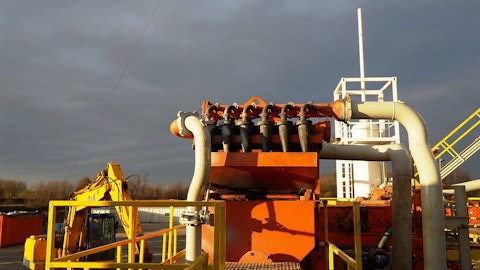Luke Brandenberg: Yeah. Great question, Jeff. Thanks for the call. The answer is yes to both. And so, we look at it from a few pieces, one, with controlled capital via strategic partnership, they’re the ones generating the opportunities, and really, we’re the capital provider for that. Another piece is, we’ve put together units, just boots on the ground. And one thing that we did this last year, and we actually are finishing up documents for another unit this year, where we scurried into an area. We saw EOG putting together a position. And so we scurried in there, started picking up leases. Weren’t the only ones that had the idea. There was another non-op group that was doing a similar thing. And so we, between the two of us, we had enough critical mass to get a drillable unit.
And so what we did is combined forces, went out and ran an RFP process, if you will, to talk to several different operators, and said, hey, we’d like to see these zones drilled. And here’s the date that we’d like to get them drilled by what would it take to get you to come in here and do that? And so that was a really neat opportunity work. I’d call it that broader controlled capital budget, because we did set the drilling plan, we did set the drilling timeline, and we were able to go out and pick the operator. So we’re doing that as well. One thing that we’re not really doing right now, not to say that we wouldn’t, but is coming in and just being a capital source alongside an operator looking to stretch their dollar, we could do that. I think it’s an interesting strategy, but we haven’t really done that to date.
Most of the opportunities that we’ve seen along those lines have a heavier production component than our typical opportunity. And so, we’ve generally shied away from them because we’ve said in the past we’re just — we’re not very good buyers of production because we just end up way off the mark from a valuation perspective. We just see more downside to upside buying production, so we tend to be more conservative, which I appreciate.
Jeff Robertson: Can you characterize how receptive some of the operators are to the terms and conditions and the type of capital that you all bring to bear in these — in the partnership concept?
Luke Brandenberg: Yeah. That’s a great question because it’s one that we’re really proud of. We came up with a bit of a new mouse trap on this control CapEx strategy, and I think it’s very appealing to the right partners. Really what it looks like is we’re taking the approach that we’re bringing the majority of the capital to the table. So we’re going to control the asset, but you, our partner, you’re going to control your company. And so, it really is more of a partnership just at the asset level to where we have control, but they fully manage their company and they own their assets outright. We don’t determine if and when they sell. That’s up to them. They really do like that. Another component I think that’s very attractive is most of these deals are really unit-by-unit deal.
We have an overall structure that we use, but they’re on a unit-by-unit deal. And so what that means is it gives the opportunity toward the operating company, but folks that are out there sourcing the deals, to earn incentives on a unit-by-unit basis, which is particularly helpful given this price environment where you’ve just seen private equity-backed exits extend. The two to four-year deal is now five to seven. But when you have a unit-by-unit carry, it really allows operators the opportunity to start realizing the fruits of their labor sooner and continue to incentivize the team and then frankly continue to reinvest because that’s what they’re doing. We’re seeing partners that are really putting material dollars back into the business because they believe in it and they want to grow it.
Jeff Robertson: Last question on the controlled capital business model your — the Permian accounts for the route on almost 50% of Granite Ridge’s first quarter 24 production. When you think about the different regions that you operate or do you see greater opportunity in some regions versus others for these types of structures.
Luke Brandenberg: Yeah. We absolutely do it. And so what we talk about at the highest level, what this is, it’s representing investments where we are taking more concentration, and we feel comfortable taking that higher concentration because we’re mitigating that by one control but also by higher expected returns. But what that means is, if you’re taking more concentrated investment risk, we want to be very sure that we’re in areas that have the highest probability of success, or, said another way, the lowest variability. And so, other areas that I think are attractive are places like the Eagle Ford, places like the Bakken, where in the right areas you have quite consistent results and just much less variability. I think that’s a big piece of the strategy.
It doesn’t mean that we wouldn’t go other places, but those are two basins that, again, are really known for their consistency and lots of development, such that you’ve got a lot of data points around you to feel good about what you’re underwriting. So I would think about basins that have low variability, that have plenty of development, and just being able to de-risk the subsurface as much as possible.
Jeff Robertson: Thank you.
Luke Brandenberg: Thank you. Appreciate it.
Operator: The next question comes from the line of Michael Scialla from Stephens. Please go ahead.
Michael Scialla: I just want to follow-up on the inventory. Luke said in the partnership, I think you said 29 net locations at the moment. Are all those in the Delaware and most of those in Loving County? I guess just looking for a little bit more color on what that inventory looks like?
Luke Brandenberg: Good question. I may have been talking too quickly. So it’s 40 gross, or 21.9 net locations that we control. Most of it is in the Delaware, but I’d say not all of it. We have some other opportunities we’re working on in the Midland, but the vast majority is in the Delaware, and of that, the vast majority is in Loving County. We have a couple deals in Reeves. We have a deal that we’re working on in Ward. And so we’re covering the broader Delaware Basin. And frankly, the driver of that is. This is one partner in particular. They’re Midland base. They’ve been there a long time. They know everybody and just have a tremendous reputation in Midland. And so they’re getting access to some unique deal flow, which we’re excited about.
But the Delaware is just far less consolidated than the Midlands. You go to the Midland basin and you look around, it’s just much harder to find undrilled units. And frankly, anything that is undrilled, there’s generally a story to it. So it’s a little bit more difficult. And as a result, just more and more deals flow out of the Delaware relative to the Midlands. That’s not intentional. We’d love to continue to put capital to work in the Midland basin as well. Again, just a quantity of deal flow versus hit rate. We’re just seeing a lot higher quality — excuse me — higher quantity in the Delaware.


